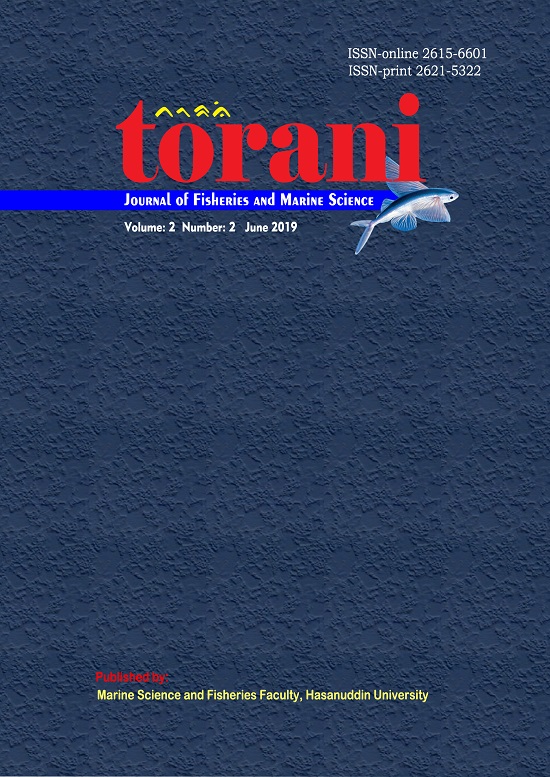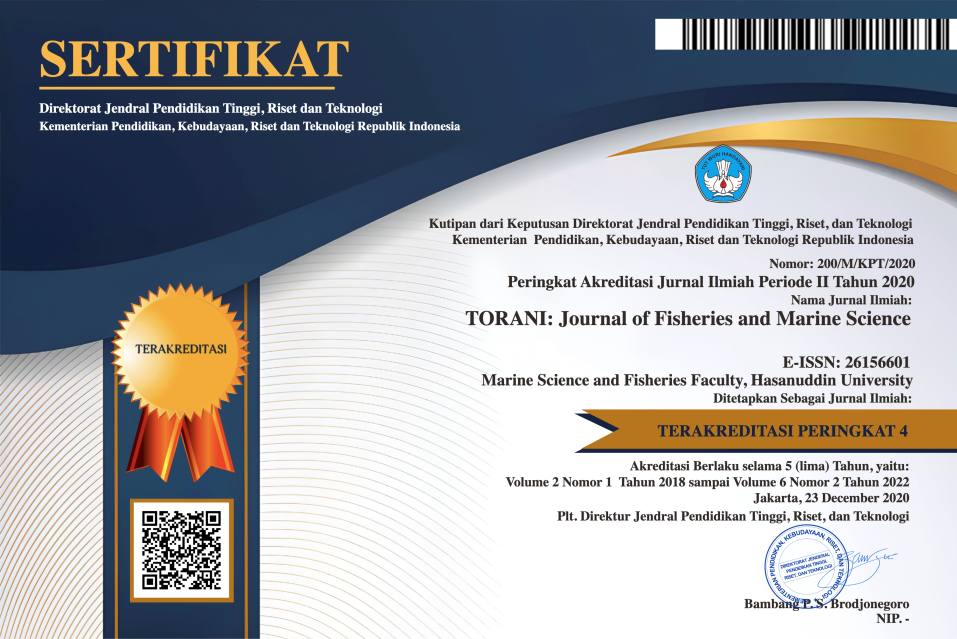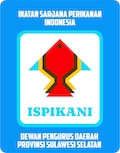Phytochemical analysis and antibacterial activity of Staurogyne sp. in fish disease bacteria
DOI:
https://doi.org/10.35911/torani.v2i2.7057Abstract
This study was aimed to identify the potential use of active compounds extracted from Staurogyne sp as an antibacterial agent to control disease-causing bacteria in fish. Staurogyne sp, an aquatic plant collected from Bantimurung, South Sulawesi were subjected to allelochemical compound. Plant extracts were tested to five bacteria including four types of bacterial pathogen, such as Aeromonas hydrophilla, Edwardsiella ictaluri, Streptococcus agalactiae, and Flavobacterium columnare, and one bacterial sensing quoroum, Chromobacterium violaceum. Based on phytochemical analysis, Staurogyne’s extracts derived from both stem and root contained flavonoids, phenols, and antioxidants compounds with the concentration of 0.018 mgQE/g, 0.3471 mgGAE/g, and 1004,391 IC50 µg/mL, respectively. In addition, Staurogyne plant extracts derived from both their stem and root has also produced both saponins and glycosides compounds. Plant extracts derived from Staurogyne’s leaves revealed three major chemical compounds such as flavonoids (0.77 mgQE/g), phenol (0.0629 mgGAE/g), and glycosides (+). However, no antioxidants and saponin compounds were detected. Applying plant extracts as an antibacterial on five disease-causing bacteria causing diseases in aquaculture, such as Aeromonas Hydrophilla, Edwardsiella ictaluri, Streptococcus agalactiae, Flavobacterium columnare, and Chromobacterium violaceum bacterials revealed that at concentration of 0.1 g the Staurogyne sp extracts did not influence all the bacterials growth. However, by application of plant extract at concentration of 0.2 g on the growth media,three out of 5 tested bacterials (Aeromonas hydrophilla, Edwardsiella ictaluri, and Streptococcus agalactiae) showed intermediate inhibition responses on bacterial growth. The growth of remaining two bacterials pathogen, Flavobacterium columnare and Chromobacterium violaceum at 0.2 g plant extract of Staurogyne sp was not affected. This study revealed that the use of active compound derived from Staurogyne sp would be potential to be used in inhibiting disease-causing bacterial in fish in future. However, optimum concentration of the plant extracts, in particular on the inhibition of the growth of disease-causing bacteria in fish is still needed to adjust.Key words: Antibacterial, aquatic plant, Staurogyne sp, fish diseaseDownloads
References
Bauer, W., M.D. , W . M . M . Kirby , M.D. , J. C. Sherries , M.D. , Axu M . Turck , M.D. 1966. Technical section antibiotic susceptibility testing by a standardized single disk methoda. The American Journal of Clinical pathology. Reprint from Technical bulletin of the registry of medical technologies. 36(3): 493-496
Cabello F, C., 2006. Heavy use of prophylactic antibiotics in aquaculture: a growing problem for human and animal health and for the environment. Environmental Microbiology Journal, 8(7), pp.1137–1144. doi: 10.1111/j.1462-2920.2006.01054.x.
FAO. 2009. World Agriculture: towards 2030‐2050 an FAO Perspective, Rome, Italy.
Gross, E,M., Meyer, H and Schilling, G., 1996. Release and ecological impact of algicidal hydrolysable polyphenols in Myriophyllum spicatum. Phytochemistry Journal, 41, pp.133-138.
Harborne, J, B., 1987. Phytochemical Methods. In: Applied Phytochemistry Method, Kosasih, P and Soediro, I (Eds.). Penerbit ITB. Bandung.
Hiura, A., T. Akabane., K. Ohtani., R.K.K. Yamasaki., Y.Kurihara. 1996. Teste – modifiying triterpene glycosides from Staurogyne merguensis. Phytochemistry Journal (43):5. 1023-1027. https://doi.org/10.1016/S0031-9422(96)00385-8.
Lemmens,R.H.M.J and B. Praphatsara. 2013. Plant resources of south-east asia. Medicinal and poisonous plants 3. Backhuys Publishers, Leiden :12(3) 666 page.
Livermore, D, M., 1995. β-Lactamases in laboratory and clinical resistance. Clinical Microbiology Reviews, pp.557–584.
McClure, J, W., 1970. Secondary constituents of aquatic angiosperms. In: Harborne JB (ed), Phytochemical Phylogeny. Academic Press (NY), pp.233-268.
MoH., 1995. Indonesian Materia Medica. 6th Edn., Ministry of Republic of Indonesia, Jakarta.
Pelczar, M. J. dan Chan, E. C. S., 1988, Dasar-Dasar Mikrobiologi, diterjemahkan oleh Hadioetomo, R. S., Penerbit Universitas Indonesia, Jakarta.
Peterson, L, R., 2005. Squeezing TheAntibiotic Balloon: The Impact of Antimicrobial Classes On Ermerging Resistance. European Society of Clinical Microbiology and Infectious Deseases.The Feinberg School of Medicine, North Western University, USA. Suppl 5, pp.4-16.
Pruden, A., Larsson, D, G, J., Amezquita, A., Collignon, P., Brandt, K, K., Graham, D, W., Lazorchak, J, M., Suzuki, S., Silley, P., Snape, J, R., Topp, E., Zhang, T and Zhu, Y, G., 2013. Management options for reducing the release of antibiotics and antibiotic resistance genes to the environment. Environmental Health Perspective, 121(8), pp.878–85. doi: 10.1289/ehp.1206446.
Rasmussen, T, B and Givskov, M., 2006. Quorum sensing inhibitors: a bargain of effects. Microbiology, 152, pp.895-904. doi: https://dx.doi.org/10.1099/mic.0.28601-0.
Saito, K., Matsumo, M., Sekine, T., Murakoshi, I., Morisaki, N and Iwasaki S., 1989. Inhibitory subtances from Myriophyllum brasiliense on growth of blue-green algae. Journal of Natural Products, 52, pp.1221-1226.
Sapkota, A, R., Lefferts, L,Y., McKenzie, S., Walker, P., 2007. What do we feed to food-production animals? A review of animal feed ingredients and their potential impacts on human health. Environmental Health Perspective, 115(5), pp.63–70. doi: 10.1289/ehp.9760.
Tacon, A,G,J., Metian, M., Giovanni, M., Turchini and De Silva, S,S., 2009. Responsible Aquaculture and Trophic Level Implications to Global Fish Supply. Reviews in Fisheries Science, 18 (1), pp.94-105.DOI: https://doi.org/10.1080/10641260903325680.
Van aller, R, T., Posseney, G, F., Rogers, V, A., Watkins, E, J and Leggett, H,G., 1985. Oxygenated fatty acids: A class of allelochemicals from aquatic plants. In: Thompson AC (ED). The chemistry of Allelopathy, ACS Symposium Series, 268, pp.387-400.
Vignesh, R., Karthikeyan, B, S., Periyasamy, N., Devanathan, K., 2011., Antibiotics in Aquaculture: An Overview. South Asian Journal of Experimental Biology, 1(3), pp.1-8.



















